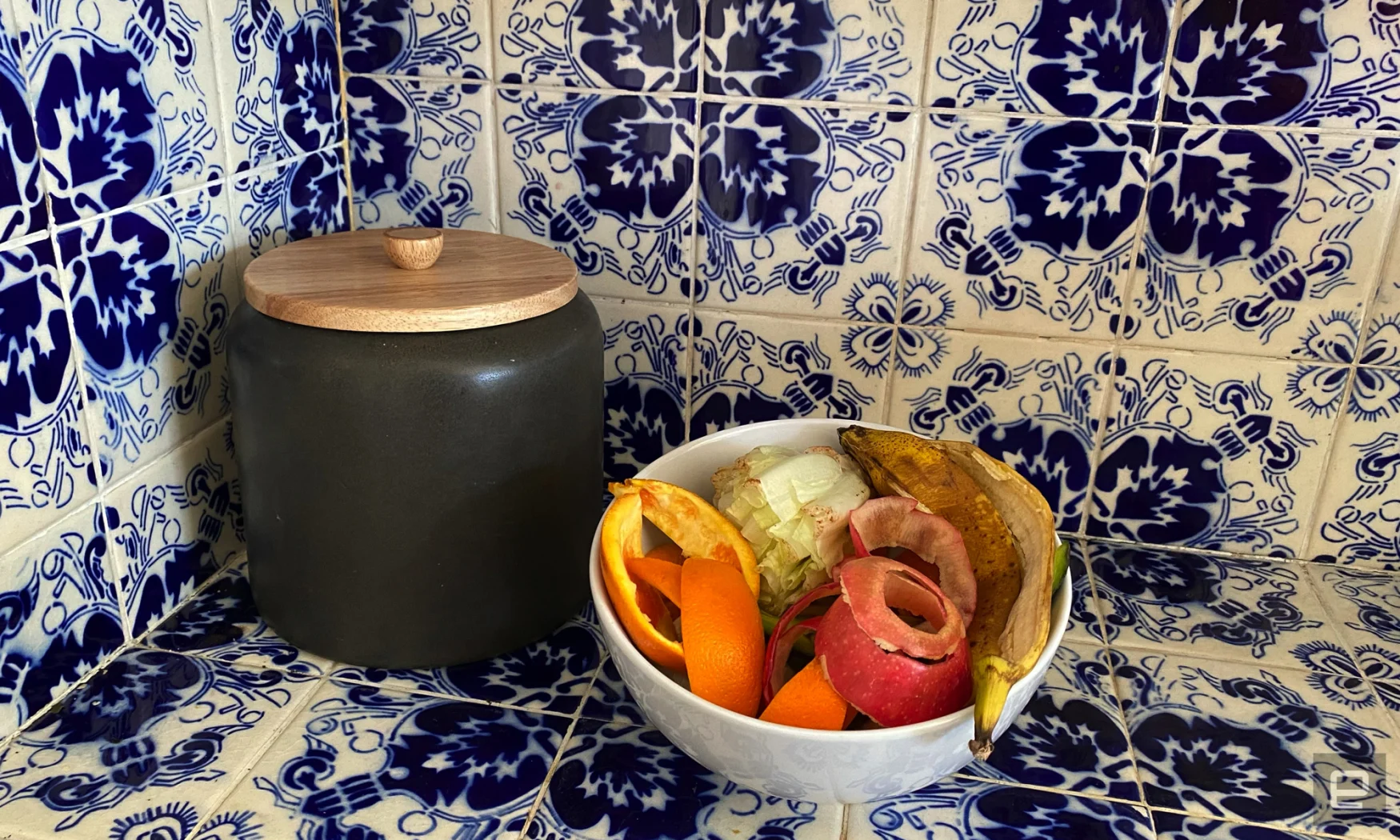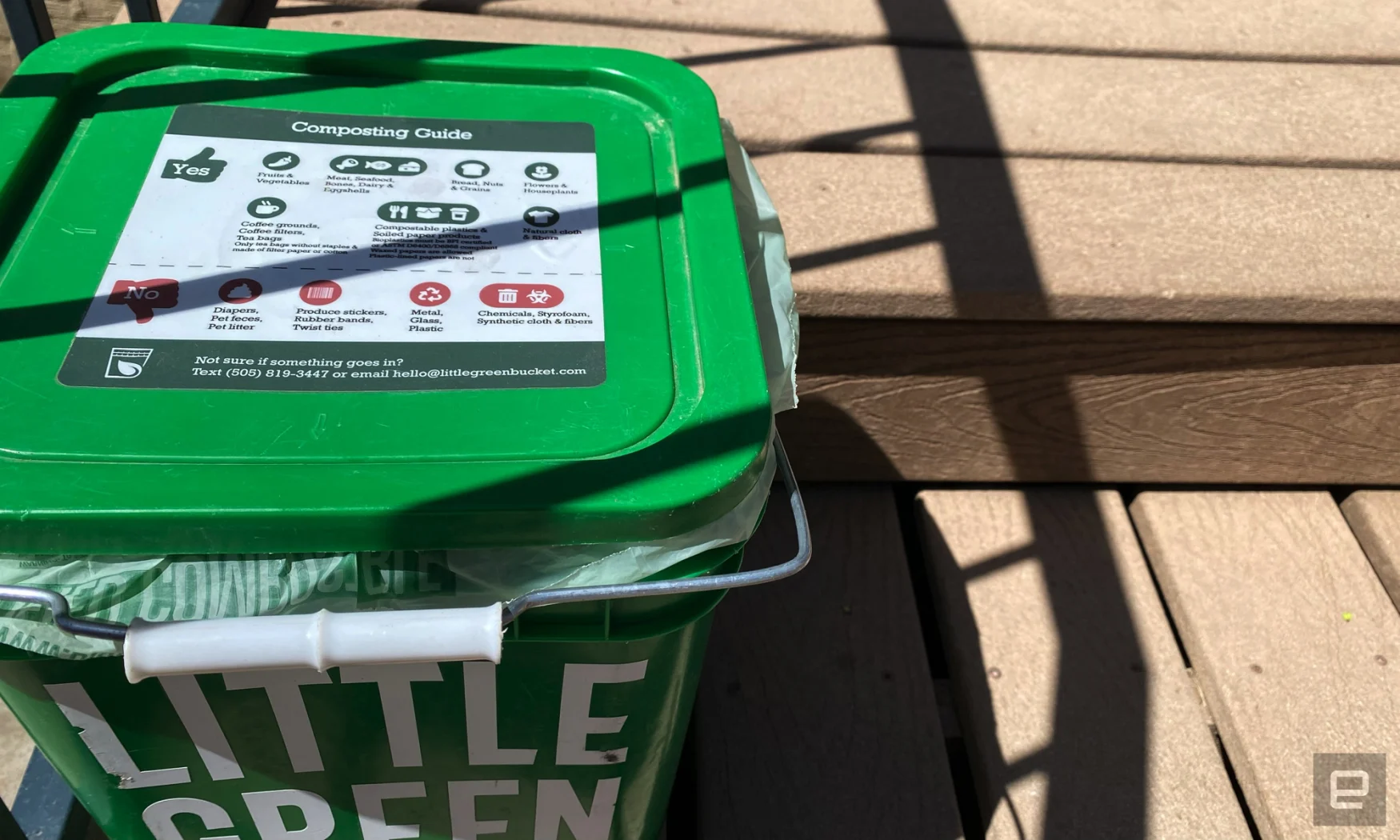All products recommended by Engadget are selected by our editorial team, independent of our parent company. Some of our stories include affiliate links. If you buy something through one of these links, we may earn an affiliate commission. All prices are correct at the time of publishing.
I’ve thought a lot about composting. It was a daily part of life for five years when I lived off-grid. Granted, we were composting more than just food, but I got to know carbon/nitrogen ratios, ideal moisture levels, proper aeration and everything else that distinguishes a healthy compost pile from an unpleasant mass of rot. Now as a city dweller, I still believe in composting and continue to do it – but no longer in my backyard.
Each person in the US throws away about 200 pounds of food per year on average. Once it hits a landfill, food waste does bad stuff, like releasing methane and contributing to climate change, instead of good stuff, like improving the soil and acting as a carbon sink. Composting solves those problems, and many cities are starting to realize it helps them with waste management, too. Nine of the 20 largest metro areas in the US now have some form of residential compost service, or will in the next year or so. But if you live elsewhere and want to stop putting your food scraps in the trash, it’s up to you. You have three main options: compost in your backyard, buy a machine or pay someone to do it for you.
How to compost at home
It’s tempting to think of composting as building a holder, throwing in food and coming back a few weeks later to something you can toss in your garden, but the reality requires much more time, space and effort. For me, the toughest part of composting was the consistency it required. At least a few times per week, any active compost pile needs tending, including adding to it, turning it, watering it in dry climates or shielding it from excess rain. In addition to time, home composting requires the space and materials to build the bins. You’ll also need a regular source of “brown” or carbon-rich materials like dried leaves, untreated paper, cardboard, sawdust or wood chips.
Plenty of people (with more knowledge than I) have put together how-tos on the subject. I followed The Mini Farming Guide to Composting, but these online guides will also serve you well:
-
EPA: Offers a high-level overview of the process and includes a handy chart with examples of green and brown materials.
-
ILSR: A more in-depth guide, complete with illustrations and the reasoning behind each step.
-
NMSU: A science-rich reference with multiple methods and troubleshooting suggestions.
-
Joe Gardener: A multi-page, highly detailed PDF from Joe Lamp’l, the host of PBS and DIY Network gardening shows.
Each source gives the same basic advice: build your bin, collect your food scraps, stockpile brown materials, maintain your ratios, monitor and amend moisture and aeration levels, then let a full heap finish for six to eight weeks (so yes, you generally need two piles).
As you can see, composting correctly isn’t as easy as chucking scraps into a bin and letting time handle the rest. Of course, if the process appeals to you (and it is pretty fascinating) that’s not a drawback. Gardeners in particular, who are out in the yard anyway, make excellent candidates for keeping up healthy piles — not to mention, they also have the most use for the finished product. People without yards, however, are out of luck (unless they’re comfortable hosting an indoor worm farm).

Photo by Amy Skorheim / Engadget
Kitchen composting machines
Calling them “composters” is a misnomer, since these devices don’t actually create compost – that requires microbial processes that take weeks. Instead, these appliances chop and dehydrate food, creating an odor-free material that’s substantially smaller in volume than what went in. You can even include meat and dairy – an advantage over home compost piles in which animal products are generally not recommended. As for what comes out, it can be added to your backyard pile, spread in your garden, added to houseplants or thrown in the green bin or trash – where it will take up less room and won’t stink anything up.
I haven’t tested any of these devices, but after researching from the perspective of a fairly informed composter, here’s what I see as the pros and cons of a few of the more popular devices on the market.
Mill ($33 – $45 per month)
I like that Mill offers a solution for the substance it produces and that it’s large enough to hold the scraps an average family might generate over the course of a few weeks. Instead of buying the machine outright, you sign up for a subscription, which includes the Mill bin and UPS pickup for the “grounds” it creates. Add food throughout the day and the dehydration, chopping and mixing cycles run automatically each night. Once it’s full, you empty the contents into a prepaid box and ship it to Mill who will then turn the grounds into food for chickens.
Mill is in the pre-order phase, and according to the FAQs, the company hasn’t yet worked through the “scientific and regulatory processes” for producing chicken feed. The service also costs $45 per month, unless you pay annually, then it works out to $33 monthly.
Lomi ($369 – $749)
Lomi also chops and dehydrates your scraps. The unit is smaller than the Mill, so you’ll likely have to empty it every few days. It offers three modes, one of which, Grow Mode, uses small capsules of probiotics called Lomi Pods to create “plant food” in about 20 hours. Lomi suggests mixing the results with regular soil at a ratio of one to ten.
If you have a yard, it’s easy enough to add a little here and there to maintain the ratio, and if you’re an apartment dweller with houseplants you can mix small amounts into the soil. But the end product should only be used sparingly, like a fertilizer, so you’ll probably need to do something else with the excess. Lomi suggests giving the excess away or dropping it into your green bin if your city provides curbside compost pickup.
Vitamix FoodCycler ($400)
All of these devices are basically blenders with a heating element, so it makes sense that Vitamix has a unit on the market. The FoodCycler is smaller than the Lomi, so it’s probably best for households with one or two people. The results can be mixed sparingly into plants, added to your green bins or thrown out. Whichever way, the processed scraps will stink less, take up less space and won’t add more methane rot to a landfill.
Reencle ($700)
Reencle is larger like the Mill bin, and involves microorganisms in the process like Lomi. You can buy it outright or rent it for $30 per month, but that doesn’t include pickup for the results. I like that Reencle is, in essence, a living pile of fermentation, using low heat, grinders and a regenerating bacterial population to break down your food scraps.
Adding scraps daily “feeds” the pile, and when it’s full, you’re only supposed to remove about half of what’s in there, leaving the rest to breed more Bacilli. Again, the material works as a plant food or fertilizer, not like standard compost. Reencle recommends a byproduct-to-soil ratio of one part to four, and that you let the mixture sit for five days before adding to your monsteras and gardens.

Photo by Amy Skorheim / Engadget
Why you should consider a composting service
DIY home composting is a lot of work. Countertop machines are expensive and, from what users say, noisy and often unreliable. Both methods leave you to figure out what to do with the byproduct, whether it’s the finished compost from your bins or the dehydrated proto-compost from the appliances.
If you’re a gardener, you’re golden – compost makes plants happy. But I’ve tried farming and now I’d rather ride my bike to the burrito stand than grow my own food. Since I don’t live in a city that offers municipal curbside organics pickup, I pay for a local service and I recommend it.
Most subscription-based compost pick-up services work the same way: for a monthly fee, they provide you with a bucket and lid. You fill the bucket with leftovers and set it on your front porch/steps/stoop on pickup day. They collect your bucket, leaving you a fresh one on a weekly, bi-weekly or monthly basis. Scraps are then composted on a large scale and the results are sold to local farms or people in the community.
Each service has different rules about what you can add, but most let you throw all food and food-related items in the bucket (including meat, bones, dairy and fruit pits). You can also usually include coffee filters, pizza boxes, houseplants, BPI-certified compostable plastics and paper towels (without cleaning products on them). All services ask that you remove produce stickers and pull the staples from your teabags.
I have our pickup scheduled for every other Tuesday. Does two weeks’ worth of food in a bucket stink? It does. To help with that, we keep our bucket outside with the lid firmly on. I keep a canister on the countertop to fill with scraps throughout the day and empty it into the bucket when the canister is full or starts to smell. I also keep old food in the fridge until right before collection day.
Of course, these services aren’t available everywhere, and they cost $20 to $40 per month, so it’s not a universal solution. I pay $22 for a twice monthly pickup and I look at the cost in terms of time: I would spend more than two hours a month maintaining a compost pile, so if I value my labor at $12 per hour, which is my state’s minimum wage, the cost is worth it.
I like the little perks too, like getting a “free” bag of compost twice per year and having a place to drop off our yearly batch of jack-o-lanterns once the faces start caving in. I also know that some of what I put in eventually goes to the lavender farm up the road from me. That’s a much better end game for my avocado pit than being sealed up for eternity in a landfill.
A sampling of composting services in the largest US markets
Modern tech is making it easier for these services to pop up in more cities. Sign-up is done online and most payments are automatic. My driver told me they use the Stop Suite app to optimize their pickup routes, send out text reminders and handle other customer service functions. Composting may be old as dirt, but the way we’re creating it is brand new.
Of the 20 largest metro areas in the US, nine have or will have municipally-run compost collection programs. Each of the other eleven areas have at least one community composting service available. Here’s a list:
-
New Jersey: Garden State Composting, Neighborhood Compost
-
Chicago: WasteNot Compost, The Urban Canopy, Collective Resource Compost
-
Dallas: Recycle Revolution, Turn Compost
-
Houston: Moonshot Compost, Zero Waste Houston
-
Washington DC: Compost Crew, Veteran Compost, Curbside Compost
-
Philadelphia: Mother Compost, Circle Compost, Bennett Compost
-
Atlanta: Awesome Possum Composting, Compost Now
-
Miami: Compost for Life, Renuable
-
Phoenix: R.City
-
Detroit: Midtown Composting, Scrap Soils
-
Tampa: Suncoast Compost
-
Albuquerque (the service I use): Little Green Bucket
Credit: Source link


Comments are closed.